Are you wondering what the reason for high superheat low subcooling is and how can affect your air conditioner? Don’t worry! You are on the right blog post. Read on as I’ll explain what these two conditions mean and explain how to solve issues in the system related to them. So without any delay, let’s head on to the next section!
High Overheating Low Subcooling: What Does it Mean and How to Fix It?
To answer quickly, here’s the simple breakdown of high superheat and low subcooling:
- High superheat refers to the elevated levels of heat added to the refrigerant after it changes from liquid to vapors. Low Subcooling is the low levels of heat removed from the refrigerant before it changes from vapor to liquid.
- High superheat and low subcooling are caused by low refrigerant charge.
- To fix this issue, you will need to charge the lines and add the liquid to the system.
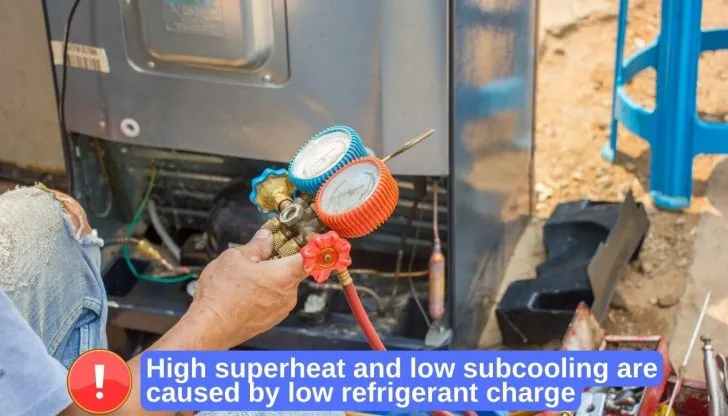
However, these are the basics only. Continue reading to fully understand the processes of high superheat and low subcooling, their causes, and how to fix them easily. Let’s dive deeper into this informative guide.
Exploring High Superheat in Detail! 4 Reasons Why It Happens
Let’s dive into the concept of High superheat and the major causes behind it:
An Insight Into Superheat
High superheat means low cooling agent. The condition of high superheat is a direct outcome of an undercharged unit that inadequately supplies refrigerant to the indoor evaporator coil.
- The amount of superheat generated depends on the amount and type of refrigerant added to the system, the load on the system, and the design of the evaporator coil.
- It’s measured where the refrigerant goes from liquid to gas at the end of the evaporator coil
- In order to measure superheat, you need to subtract the actual temperature of the refrigerator from the saturation temperature difference.
To learn more, check out this video.
Read Also: Low Superheat High Subcooling: 7 Reasons and Troubleshooting
Listed below are some most-known high superheat causes on TXV systems, with their fixes.
A Quick Look
I have illustrated the causes and their fixes in the table below:
Causes of High Superheat | Possible Fixes |
Insufficient liquid flow | Check or replace the metering device |
Constricted Liquid Line | Inspect or clear the filter dryer or any bent pipes |
Low refrigerant level | Recharge with enough refrigerant |
Elevated Heat Load | Verify the AC sizing |
Now I’ll explain these causes in detail:
1. Insufficient Liquid Flow due to Faulty Metering Device
In the event of a metering device becoming defective or encountering restrictions, it subsequently hampers the flow of coolant to the evaporator, thereby resulting in elevated superheat levels.
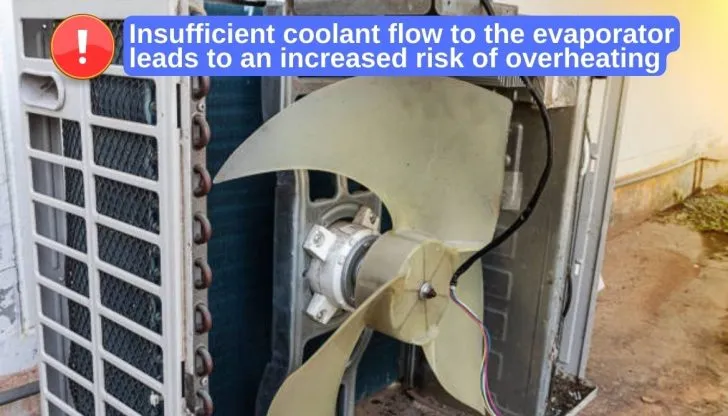
The following are the major reasons you should know:
- Something blocking the small opening in the TXV resulting in the clogging.
- A thermostatic expansion valve problem.
- Oil-covered TXV due to compressor flooding caused by the cooling agent.
To solve this, Freeze a portion of the TXV orifice due to too much moisture in the system. TXV should be tightly closed off.
2. Constricted Liquid Line
Everything from the receiver to the TXV is considered part of the water line. This means that all components in the liquid, like the filter dryer, can get blocked by dirt and too much moisture.
Here are some additional elements that can impede the flow of liquid:
- Soldered liquid line with flow obstructions,
- Sludge produced by compressor burnout’s waste products,
- The system contains too much oil.
In order to rectify this, clean up the condenser and evaporator coil and ensure its maintenance.
3. Low Refrigerant Level
When the system lacks sufficient refrigerant, it can lead to these problems:
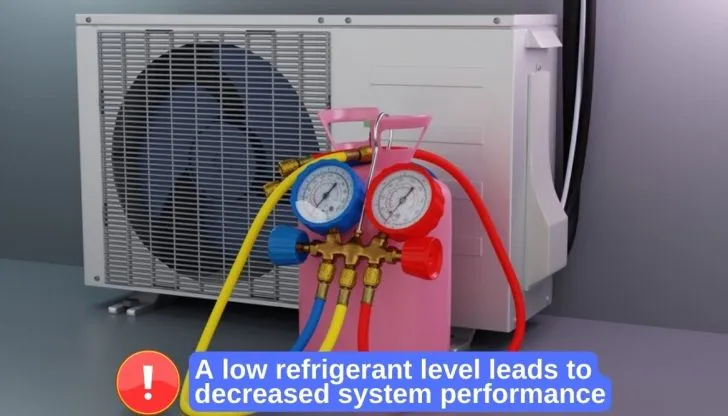
- When there is not enough refrigerant or any leaks, it can make your system work poorly.
- When there’s too little refrigerant, it can lead to high superheat, or low subcooling.
To address this, charge up the refrigeration in the system.
4. Elevated Heat Load
Listed below are a couple of reasons behind this issue:
- When there’s too much heat in the evaporator, it leads to high superheat.
- An exceptionally high temperature or an inadequately sized air conditioning system might both contribute to an excessive heat load in the evaporator.
To resolve this issue, make sure the system is not overloaded and has proper airflow to reduce the heat load in the system.
Exploring Low Subcooling in Detail!
The amount of refrigerant at the condenser is gauged by subcooling. Low subcooling occurs when there is insufficient or little coolant present at the condenser.
- In the case of low subcooling, the refrigerant is not fully condensed.
- It can reduce the cooling capacity and efficiency of your HVAC system.
- It may also cause damage to the compressor and condenser coil.
To get more insights, you can also check out this video.
A Quick Look
Let’s have a quick glance over the causes of Low subcooling and how to fix them:
Causes of Low Subcooling | Solution |
Limited Air Movement in the Condensor | Clean condenser unit |
Malfunctioned Metering Devices | Examine the metering drive and, if necessary, replace it |
Refrigerant Leakage | Add enough refrigerant to the charge |
Defective Compressor | You’ll need new compressor parts if the old ones are worn out |
Now I will go in-depth for each one of them:
1. Limited Air Movement in the Condensor
Restricted airflow leads to high temperatures and pressure buildup in the condenser. High pressures can cause refrigerant leaks at the condenser, leading to high superheat and low subcooling.
To avoid these issues, ensure sufficient airflow by keeping condenser coils and fins clean.
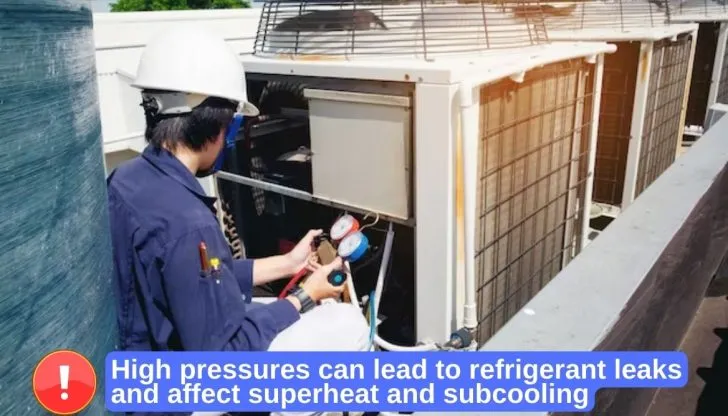
2. Malfunctioned Metering Devices
The metering tool controls the refrigerant flow. A malfunctioning tool can result in refrigerant flow restriction to the condenser. To tackle this issue, clean the metering device. If the issue persists, consider replacing the meter power head
3. Refrigerant Leakage
Low refrigerant charge is the culprit behind low subcooling. These low levels of refrigerant are caused by leaks in the system. To overcome such an issue, it is recommended to prioritize leak detection before adding refrigerant.
4. Defective Compressor
A malfunctioning compressor leads to refrigerant deprivation in the condenser.
- This issue can stem from a faulty capacitor or other components of the compressor.
- Component replacement is usually affordable and simple if it’s not the entire compressor.
- In the case of a dead compressor, a complete replacement is necessary.
For a better understanding, here’s a helpful video you should definitely check out.
Comprehensive Guide to Fixing the Top 14 Problems HVAC System
Let’s look at the most common problem you will have with your cooling system and how to keep it in peak condition:
Issue | Possible Reasons | Solution |
Low Subcooling and High Superheating | When the subcooling is low and the superheating is high, then it is usually indicative of low refrigerant charge on suction and liquid lines causing these malfunction | Locate and seal leaks, then recharge with sufficient refrigerant |
Low Subcooling and Low Superheating | This can result from incorrect Thermal Expansion Valve (TXV) adjustment if the orifice is too large or the TXV is overly opened | To rectify the issue you need to adjust TXV and make sure te the flow of the refrigerant is proper |
High Subcooling and Low Superheating | When there’s too much refrigerant in the liquid and suction lines, this can cause high levels of subcooling but low levels of superheating | To resolve this, you will need to remove the excess refrigerant from both the suction lines and the liquid |
High Subcooling and High Superheat | Several factors allow for high subcooling and high superheat such as restricted TXV or dryer valve, clogged or constricted coil, insulation, and TXV issues | To address this, you will need to check insulation and TXV for any kind of problems |
Minimal Superheat | When the system is overcharged and there is no indoor airflow or poor flow of air, then you will face the issue with minimal superheat | To remedy this, you need to recharge the system after removing some excess refrigerant and make sure the airflow is properly regulated |
Extreme Superheat | If there is a low refrigerant charge and poor outside airflow then you will face extreme superheat | To rectify this situation, you will need to add refrigerant, clean the condenser coil, and make sure it is functioning properly |
Minimal Subcooling | You can face the issue of minimum subcooling when there is a low refrigerant charge and poor filter drier | You will need to clean the condenser unit, and the filters and add system refrigerant to the HVAC |
High Subcooling | If you have weak compressor valves or an overcharged system, then you may face the issue of high subcooling | To resolve this issue, you need to replace the compressor and release some excess refrigerant to get the perfect temperature |
Low Suction Pressure | In case of insufficient ventilation and a low refrigerant charge, this often results in a low suction pressure line | You will need to replace air filters, and recharge the system with freon to address this issue |
Minimal Head Pressure | Weak compressor valves coupled with low charge can lead to minimal head pressure | To tackle this issue, you should swap out the compressor coil and refill the system with the right amount of refrigerant |
Elevated Suction Pressure | High levels of pressure of the suction line are often caused as a result of low outside airflow, weak compressor valves, and overcharging of the system | To resolve this, simply clean the condenser, remove excess freon, and replace the compressor if necessary |
Low-TD Indoors | When there’s a low-temperature difference indoors, it is often characterized by low outside airflow or issues with the compressor valve | You can address this by making sure the condenser is in optimal condition or replacing the compressor coil |
TD High Indoors | A high-temperature difference indoors can be caused by to lack of indoor airflow | You will need to ensure that the air filters and coils are properly cleaned, vacuumed, and air-dried |
Refrigerant Line | If you have a high superheat low subcooling problem due to low refrigerant lines there are only 2 possible explanations for that: 1. Initial Undercharging: New AC units with high superheat and low subcooling may have been undercharged during installation. | 1. Leak Detection and Sealing: Techs use a nitrogen test to find and seal leaks with appropriate sealants. |
A Step-by-Step Guide For Determining Superheat and Subcooling with 2 Examples
Here is a quick guide on how to determine whether your system is plagued by superheating or subcooling:
1. Requirements
You will need the following in order to check a system for superheating:
- An exclusive thermometer for measuring pipe temperatures
- R-22 Chart for converting from temperature to pressure while taking a measurement
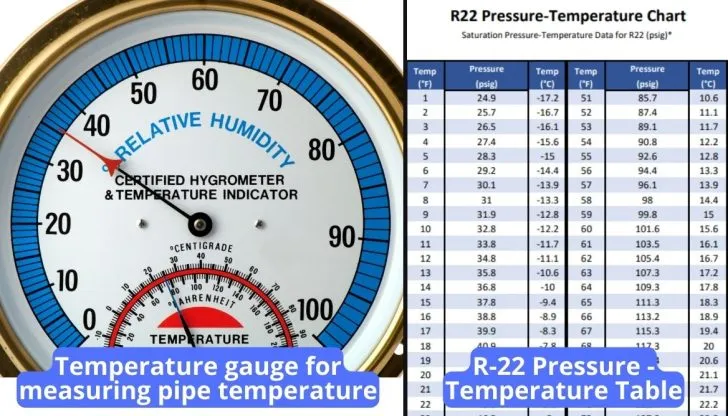
2. Procedure
Here is a quick look at the method you need to follow:
- Check the suction line temperature.
- Use the chart to change suction line pressure into temperature.
- Find the temperature difference for superheating.
- Typically, it’s 10 degrees at the evaporator and 20-25 degrees near the compressor.
Example 1: Checking Superheat
Let’s explore this with the help of an example:
- Check the temperature difference in the suction line between low superheat and normal subcooling, which let’s say is 51°F in this example.
- Also, record the suction pressure, which is 70 psi (converts to 41°F using an R-22 temperature-pressure chart).
- Calculate the temperature difference: 51°F – 41°F = 10°F.
- A superheat of 10°F is expected at the evaporator. More than that is “high,” and less is “low.”
Example 2: Checking Subcooling
Let’s look at another example:
- Subcooling in TXV systems typically ranges from 10°F to 18°F.
- To measure normal subcooling in an R-22 system, attach a thermometer near the liquid line at the condenser. For example, with a temperature reading of 90°F and a head pressure of 278 psi, the calculated temperature is 125°F.
- Calculate the temperature difference: 125°F – 90°F = 35°F.
- If the temperature difference is above the normal subcooling, it indicates high subcooling. Below the range, it’s low subcooling, and within the range, it’s normal subcooling
FAQs
What to do if the superheat is too high?
If the superheat is too high then you need to add your refrigerant and check the system for any airflow obstructions.
What does it mean when subcooling is low?
When the subcooling is low, it means that the refrigerant is not losing enough heat in the condenser coil.
What to do if subcooling is too low?
If the subcooling is too low then you can try lowering the flow of the refrigerant in the condenser coil and check for any leaks.
Conclusion
To sum it up, high superheat and low subcooling are the two conditions that can greatly affect a system’s efficiency. They can happen when there is an undercharge of refrigerant.
To fix them high superheat and low subcooling, you should check the refrigerant flow, airflow, metering device, condenser coil, and refrigerant coil. During troubleshooting these issues, also consider looking at the cooling load, ambient temperature, and system design to make sure it operates at maximum efficiency.
Recommended read:
How to Charge the Nest Thermostat? Some Effective Ways
How to Unlock a Honeywell thermostat? Easy Unlocking Hacks
